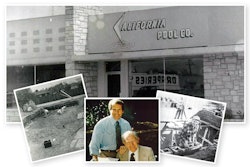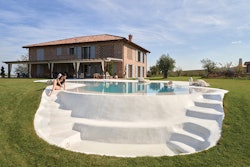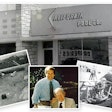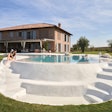
Hydraulic efficiency, variable-speed pump technology in particular, has enabled pool owners to significantly lower power consumption — a boon for consumers, the industry, regulators and lawmakers alike.
Yet variable-speed pumps are really only part of the story. While the ability to adjust pump speed opens the door to a variety of energy efficiencies in the backyard, there is also the matter of the resistance the system provides — also known as the head loss, measured as total dynamic head — which directly impacts the energy required to filter and circulate the water over a given stretch of time.
SEEKING BALANCE
Every length of pipe, fitting, valve and component in a plumbing system contributes to the resistance the pump must overcome. Those elements are typically fixed in the amount of head loss they contribute, but the filter is an exception in that the resistance is always changing — the media loads with dirt and is then cleaned by backwashing or cartridge cleaning. Add in the issues of filter sizing and performance characteristics of media type, and you’ll find understanding the role of filtration in hydraulic efficiency can be surprisingly nuanced.
“Filters definitely do play a part, but it’s not something intuitive because with filters, there’s no power associated directly,” says Scott Petty, global product manager for pumps and filters for Hayward Pool Products. “You’re not plugging them in, so it’s not something most people think about immediately. But they do impact power consumption because they present resistance to the pump. Obviously, the more resistance, the harder the pump has to work and the more energy you end up consuming.”
Experts in hydraulics and filtration like Petty are quick to point out that no one should think in terms of sacrificing water quality for hydraulic efficiency. Still, there are ways to enhance efficiency and still maintain clean water.
RELATED: Maximizing Efficiency
“Every pool has to have at least a pump and a filter,” Petty says. “Filters by definition provide resistance and head loss to the system, so they certainly impact hydraulic- and energy efficiency. Obviously you can’t take that to zero, but you can reduce some of that head loss and energy consumption while effectively filtering the water. There’s a balance. Within the different filter categories, there are things you can do reduce resistance.”
Ironically, Petty adds, as filters load with debris and add more resistance, they actually improve filtration. “To an extent,” he says, “a dirty filter is actually better than a clean filter because the debris that’s already been filtered helps ‘grab onto’ the other debris that passes through it. Of course, the more debris accumulated, the more head loss and it becomes less and less efficient. You certainly don’t want the pressure to increase over the manufacturer-recommended maximum pressure because once you go beyond that you’re no longer adding benefit; you reach the point of diminishing returns.”
IS BIGGER BETTER?
Proper filter sizing is arguably the first consideration in finding the balance between hydraulic efficiency and filter performance, and to a point that means larger filters are superior to smaller ones.
“Filters are one of the few categories that fit the American mentality that bigger is better,” Petty says. “With pumps, by comparison, if you go too big, you’ll create issues like wasting energy and cavitation, for example. With filters, you almost can’t go too big in terms of efficiency. The larger the filter, the longer you’re going to go between having the clean them.”
Because filters are sized by filtration area, proponents of cartridge filters will point out that the pleated design offers a big advantage. According to Richard Medina, Pleatco’s vice president of operations and engineering, “If you compare what happens in a cartridge filter vs. sand or D.E., all things being equal, there will be less head loss in a cartridge filter, largely because there’s so much more filtration area, more media to distribute the debris. Because the area is larger, the pressure increase is much smaller.”
Things become trickier when considering the differences among the three basic media types as efficiency relates to the micron size being filtered. It’s long been accepted that D.E. provides the finest level of filtration, with cartridges the second smallest and sand the largest. Intuitively it might seem that the finer the particles size being filtered, the greater the resistance. While that is theoretically true, other factors complicate the equation.
RELATED: Selling Variable Speed
“If you think of it as a tree diagram, most people in the industry are focused on the energy-efficient pump, which would be the trunk of the tree, but there are the branches that impact efficiency,” Medina says. “In terms of filters, there’s the type of media, the size of the filter, the environmental conditions and the differences between filter manufacturers. There’s the plumbing size and the layout or the hydraulic characteristics of an in-line chlorinator, for example. All of those things factor in and nobody is really talking about them.”
Added to all of that is the fact that media type is often a function of regional preference and convention. “Sometimes it’s for technical reasons such as the environmental factors, but often it’s really just the way it’s always been done,” Petty says. “If you go into Florida it’s almost all single-element cartridge filters, but if you go into the other gulf states it’s mostly sand filters. It’s very regional.”
Despite this regional bias, manufacturers do report that cartridge filters are the category experiencing the most growth. “That’s certainly not to say that sand and D.E. are going away,” Petty says, “but cartridge filters are the fastest-growing of the three filter types. It’s not like the situation with variable-speed pumps where it’s clear the market is going in that direction, the types of filters all have their pros and cons and that’s not going to change.”
THE BACKWASH VALVE
“With the use of a cartridge filter you eliminate the need for a backwash valve,” Petty explains. “With sand and D.E. you have to have a backwash valve. Any time you bend water, you’re creating additional resistance. Valves by definition are moving water through a very tight space. With a backwash valve, it’s comparable to having a bunch of 90-degree elbows on the pad. When it comes to head loss and efficiency, there is a clear distinction because cartridge filters don’t have that multi-port valve.” (See “Efficiency Upgrades.")
While the backwash valve is arguably the most significant factor in terms of filtration-related head loss, the benefit of not having one is to some extent offset by the need to remove and clean cartridges.
“Of course, cartridges do have to be cleaned,” Medina says. “One of the things we look at is how easy the material we’re using will shed debris. When you look at dirt-handling capacity, it goes hand in hand with service life. You use less water because you don’t have to clean it as often. How frequently you have to clean depends on variables including the size of the filter, the location and the environmental conditions.”
A SYSTEMS APPROACH
With so many factors influencing a filter’s hydraulic performance, it’s best considered in context of a breadth of factors such as the plumbing size and layout, the hydraulic characteristics of other components, the desired turnover rate and environmental factors.
RELATED: Is it the Filter's Fault? Probably Not
“When we talk about efficiency and filtration,” says Christine Schaeffer, vice president of Unicel, “it’s almost always about water efficiency. For example, how much water does it take to clean a sand, D.E. or cartridge filter? I’m not at all sure people are giving much thought to how much less or more energy efficiency is based on the filter element. “
Schaeffer does acknowledge that improving hydraulic efficiency of the system as a whole is an important objective, and she is enthusiastic about the role cartridge filters can play in that effort, especially with the use of variable-speed pumps. But she also stresses the importance of taking a systems-based approach.
“When you consider the marginal contribution of the filter element, the punchline requires ‘all things being equal,’” she says. “But in our industry you can’t hold all other things constant. Consider, for example, how each subsequent pass of water through the filter changes the equation. You can’t even hold that important variable constant for two passes. Conceptually it makes sense that the filter element plays a part, but I ask how can you measure the difference made by the filter element?”
She concludes: “When we take into account the many variables in the filter system itself, the environment and the way people maintain the pool, the bather load and the characteristics of those bathers, we have a systems approach to filter element performance and can better speak to the relationship between the filter element and hydraulic efficiency, although we may not be able to strictly quantify it.”








































